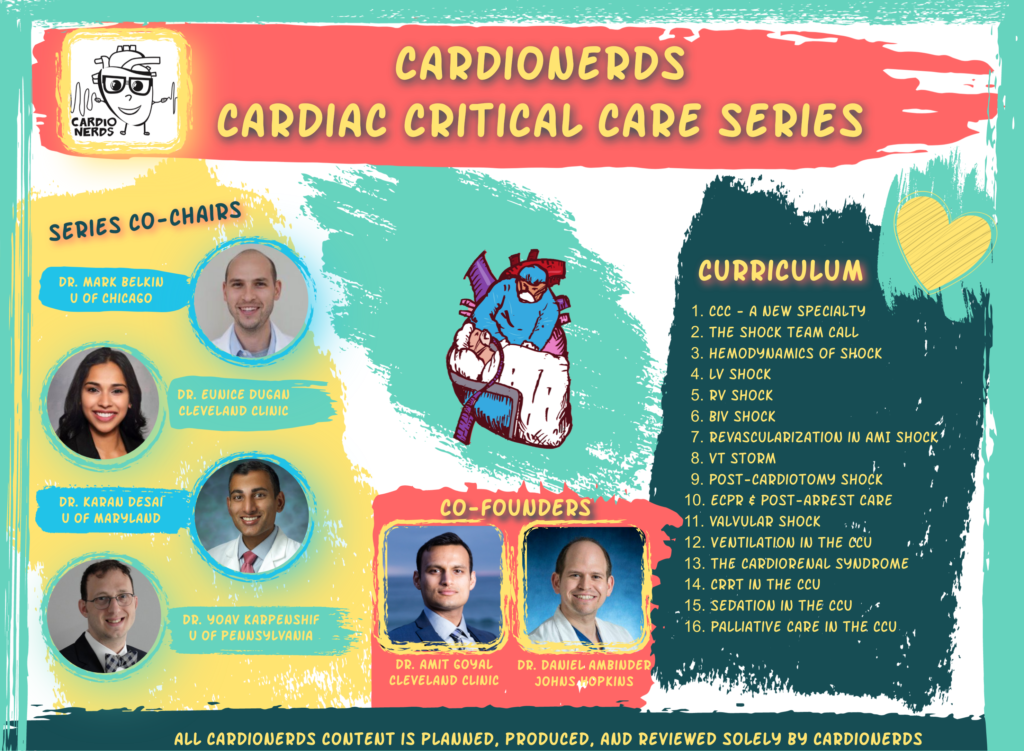Cardionerds: A Cardiology Podcast

247. CCC: Biventricular Failure and the Use of VA-ECMO with Dr. Ann Gage
In this episode, we discuss the utility of veno-arterial extra-corporeal membrane oxygenation (VA-ECMO) for the temporary management of biventricular failure and cardiogenic shock requiring full cardiopulmonary support. Here, we define the types of ECMO and describe the unique physiology of this mechanical circulatory support platform, as well as review the potential complications and management strategies. Most notably, we highlight indications for and contraindications to the use of VA-ECMO and review the importance of patient selection. Lastly, we discuss de-escalation and de-cannulation strategies for patients on VA-ECMO as a bridge to recovery.
Join Dr. Amit Goyal (CardioNerds Cofounder and FIT at Cleveland Clinic), Dr. Yoav Karpenshif (Series Co-chair and FIT at University of Pennsylvania), and Dr. Megan Burke (Episode FIT Lead and FIT at University of Pennsylvania) as they learn about how to care for some of our sickest patients from Dr. Ann Gage, interventional and critical care cardiologist at Centennial Heart. At the beginning of the episode, enjoy a message from the very first CardioNerds Scholar, Dr. Katie Vaughan (Chief Resident and soon Cardiology Fellow at BIDMC). Episode notes were developed by Dr. Megan Burke. Audio editing by CardioNerds Academy Intern, Hirsh Elhence.
The CardioNerds Cardiac Critical Care Series is a multi-institutional collaboration made possible by contributions of stellar fellow leads and expert faculty from several programs, led by series co-chairs, Dr. Mark Belkin, Dr. Eunice Dugan, Dr. Karan Desai, and Dr. Yoav Karpenshif.
Pearls • Notes • References • Production Team

CardioNerds Cardiac Critical Care Page
CardioNerds Episode Page
CardioNerds Academy
Cardionerds Healy Honor Roll
CardioNerds Journal Club
Subscribe to The Heartbeat Newsletter!
Check out CardioNerds SWAG!
Become a CardioNerds Patron!
Pearls and Quotes – Biventricular Failure and the Use of VA-ECMO
- Veno-arterial extracorporeal membrane oxygenation (VA-ECMO) is a form of temporary mechanical circulatory support that can do the work of both the heart and lungs.
- The ECMO circuit is a narcissist, i.e. cannulas are named in reference to the circuit and not the patient (“inflow” vs “outflow”).
- The decision to utilize ECMO should be made by a multidisciplinary shock team and patient selection is KEY!
- ECMO physiology rule #1: VA-ECMO increases LV afterload
- Patients on VA-ECMO should be monitored with a PA catheter and an arterial line in the right arm
Show notes – Biventricular Failure and the Use of VA-ECMO
Notes drafted by Dr. Megan Burke.
1. What is ECMO and what are the different types?
- Extracorporeal membrane oxygenation (ECMO) is a temporary form of mechanical life support that comes in two flavors: veno-arterial, or “VA” and veno-venous, or “VV.”
- VV-ECMO supports extracorporeal gas exchange in the setting of acute respiratory failure
- VA-ECMO provides full circulatory support in addition to gas exchange, doing the work of both the heart and lungs.
2. What are the components and “anatomy” of the VA-ECMO circuit?
- The circuit is made up of the following major components:
- Venous (inflow) cannula
- Centrifugal Pump
- Oxygenator (also responsible for CO2 removal)
- Arterial (outflow) cannula
- Venous (inflow) cannula
- The cannulas are named in reference to the ECMO circuit, not the patient. Dr. Gage suggests that we think of the ECMO circuit (and mechanical circulatory support in general) as narcissistic, i.e. flow is always in reference to the device.
- Gas exchange happens in the oxygenator. In the oxygenator blood flows through thin filaments that allow for diffusion of oxygen and carbon dioxide. Gas flows in the opposite direction of blood flow to maximize diffusion through the countercurrent effect. Oxygenation is determined by rate of blood flow through the oxygenator and FiO2 delivered. Carbon dioxide removal is determined by rate of countercurrent gas flow, referred to as the sweep speed.
3. What are the indications for VA-ECMO?
- VA-ECMO is utilized in the setting of severe refractory cardiogenic shock (in the setting of left, right, or biventricular failure) and cardiac arrest. It is a temporary mechanical circulatory support platform, and should be used as a bridge to recovery or a more durable therapy (i.e. durable mechanical support or transplant). Due to lack of randomized data, there are no consensus guidelines for the use of VA-ECMO, and the decision to implement it should be made as part of a multidisciplinary cardiogenic shock team. Common indications include cardiogenic shock, refractory ventricular arrhythmias, massive pulmonary embolism, cardiac arrest, and failure to wean from cardiopulmonary bypass during surgery. The absolute and relative contra-indications to ECMO vary by institution.
- Given the high mortality rates for patients on VA-ECMO (hospital mortality is approximately 50%, and 6-month survival is as low as 30%), patient selection is key. There are multiple pre VA-ECMO risk factors independently associated with poor outcomes. These include older age, female sex, higher body mass index, and markers of increased severity of illness including laboratory evidence of end-organ dysfunction and longer duration of mechanical ventilation.
4. What are the pathophysiological consequences of VA-ECMO and how do we monitor and treat them?
- The goal of VA-ECMO is to provide perfusion, however unlike other forms of mechanical circulatory support, it is NOT supporting the heart’s ability to pump blood. In fact, VA-ECMO increases left ventricular afterload, because blood enters the aorta from the outflow cannula somewhere between the aortic root and the diaphragm (depending on cannulation strategy). This creates increased aortic pressure and increased left ventricular volume and afterload, which can lead to pulmonary edema and worsened myocardial demand. In the most extreme cases, the aortic pressure can exceed the left ventricular systolic pressure, thereby preventing blood from ejecting from the LV. This can lead to stasis, thrombus formation, and strokes. For this reason, echocardiography is used frequently to monitor LV ejection. One key marker is the opening of the aortic valve with every beat.
- Furthermore, hemodynamic monitoring with a pulmonary artery catheter and a RIGHT radial arterial line is essential for management of patient’s on ECMO.
- The PA catheter allows for an estimation of the filling pressures. Of note, the mixed venous O2 cannot be used to estimate cardiac output when a patient is on VA-ECMO, but low levels still do correlate with poor tissue perfusion and worse outcomes.
- In general, it is essential to have an arterial catheter in a patient on VA-ECMO to monitor for arterial pulsatility, which is a surrogate for the contribution of the patient’s heart to perfusion.
- Specifically, a RIGHT radial arterial line is key in these patients because blood from it originates the brachiocephalic artery, which is the closest branch in the aortic arch to the coronary arteries and great vessels of the aortic arch and therefore best estimates the oxygen content in the coronaries and brain. This is key because when a patient is on peripheral VA-ECMO, oxygenated blood arrives to the heart retrograde from the femoral artery. If the left ventricle retains or regains contractility, the poorly oxygenated blood from the lungs (in patients with concurrent significant respiratory failure) is ejected into the proximal aorta. This can lead to the so called “North-south” or “Harlequin” syndrome, where the head and right upper extremity are relatively hypoxic compared to the rest of the body. Arterial blood gases from a right radial arterial line can forewarn of possible coronary and cerebral hypoxia during LV recovery as this syndrome develops and the “mixing” cloud develops.
- The PA catheter allows for an estimation of the filling pressures. Of note, the mixed venous O2 cannot be used to estimate cardiac output when a patient is on VA-ECMO, but low levels still do correlate with poor tissue perfusion and worse outcomes.
- For patients with poor ejection, there are various strategies to decompress, or “vent,” the left ventricle. Strategies include use of medicines to reduce afterload and/or improve inotropy, creation of an atrial septal defect to offload the left heart, and use of temporary mechanical circulatory support devices (IABP or percutaneous LVAD) to allow blood to more easily leave the LV.
- Treatment of the North-South Syndrome focuses on increasing the oxygenation of blood ejecting from the left ventricle through vent management or adding another venous catheter to pre-oxygenate blood before entering the lungs (VAV-ECMO). Increasing VA-ECMO flow can also shift the mixing zone towards the aortic arch and improve oxygenation, but this will also increase the LV afterload.
- Other complications of the ECMO circuit include infection, bleeding, and limb ischemia (due to the large bore vascular access), as well as stroke, hemolysis, and thrombus formation (due to the extracorporeal circuitry).
5. How is VA-ECMO weaned?
- If a patient is on VA-ECMO support as a bridge to recovery, the ability to wean a patient off the circuit relies on invasive hemodynamics, echocardiography, and an assessment of improving end-organ function.
- The flow of blood out of the circuit can be gradually weaned down to allow for the patient’s native heart to do more of the work of perfusion. Once the patient is thought to be ready for decannulation it is common to perform a turndown study under echocardiographic guidance, where serial evaluations of biventricular function are done at different flow speeds.
- VA-ECMO is usually decannulated in the operating room to allow for surgical repair of the vasculature in the setting of large bore access.
References – Biventricular Failure and the Use of VA-ECMO
- Papolos AI, Kenigsberg BB, Berg DD, Alviar CL, Bohula E, Burke JA, Carnicelli AP, Chaudhry SP, Drakos S, Gerber DA, Guo J, Horowitz JM, Katz JN, Keeley EC, Metkus TS, Nativi-Nicolau J, Snell JR, Sinha SS, Tymchak WJ, Van Diepen S, Morrow DA, Barnett CF; Critical Care Cardiology Trials Network Investigators. Management and Outcomes of Cardiogenic Shock in Cardiac ICUs With Versus Without Shock Teams. J Am Coll Cardiol. 2021 Sep 28;78(13):1309-1317. doi: 10.1016/j.jacc.2021.07.044. PMID: 34556316.
- Burkhoff D, Sayer G, Doshi D, Uriel N. Hemodynamics of Mechanical Circulatory Support. J Am Coll Cardiol. 2015;66(23):2663-2674. doi:10.1016/j.jacc.2015.10.017
- Guglin M, Zucker MJ, Bazan VM, et al. Venoarterial ECMO for Adults: JACC Scientific Expert Panel. J Am Coll Cardiol. 2019;73(6):698-716. doi:10.1016/j.jacc.2018.11.038
- Keebler ME, Haddad EV, Choi CW, et al. Venoarterial Extracorporeal Membrane Oxygenation in Cardiogenic Shock. JACC Heart Fail. 2018;6(6):503-516. doi:10.1016/j.jchf.2017.11.017
- Rao P, Khalpey Z, Smith R, Burkhoff D, Kociol RD. Venoarterial Extracorporeal Membrane Oxygenation for Cardiogenic Shock and Cardiac Arrest. Circ Heart Fail. 2018;11(9):e004905. doi:10.1161/CIRCHEARTFAILURE.118.004905
- Tehrani BN, Truesdell AG, Psotka MA, et al. A Standardized and Comprehensive Approach to the Management of Cardiogenic Shock. JACC Hear Fail. 2020;8(11):879-891. doi:10.1016/j.jchf.2020.09.005
- Grant C, Richards JB, Frakes M, Cohen J, Wilcox SR. ECMO and Right Ventricular Failure: Review of the Literature. J Intensive Care Med. 2021;36(3):352-360. doi:10.1177/0885066619900503
- Debaty G, Babaz V, Durand M, et al. Prognostic factors for extracorporeal cardiopulmonary resuscitation recipients following out-of-hospital refractory cardiac arrest. A systematic review and meta-analysis. Resuscitation. 2017;112:1-10. doi:10.1016/j.resuscitation.2016.12.011
- Russo JJ, Aleksova N, Pitcher I, et al. Left Ventricular Unloading During Extracorporeal Membrane Oxygenation in Patients With Cardiogenic Shock. J Am Coll Cardiol. 2019;73(6):654-662. doi:10.1016/j.jacc.2018.10.085
- ELSO General Guidelines Extracorporeal Life Support Organization (ELSO) General Guidelines for All ECLS Cases.; 2017. www.elso.org. Accessed April 10, 2021.
- Su Y, Liu K, Zheng JL, Li X, Zhu DM, Zhang Y, Zhang YJ, Wang CS, Shi TT, Luo Z, Tu GW. Hemodynamic monitoring in patients with venoarterial extracorporeal membrane oxygenation. Ann Transl Med. 2020 Jun;8(12):792. doi: 10.21037/atm.2020.03.186. PMID: 32647717; PMCID: PMC7333156.
CardioNerds Cardiac Critical Care Production Team
 Karan Desai, MD
Karan Desai, MD Dr. Mark Belkin
Dr. Mark Belkin Dr. Yoav Karpenshif
Dr. Yoav Karpenshif Amit Goyal, MD
Amit Goyal, MD Daniel Ambinder, MD
Daniel Ambinder, MD






 Visit Podcast Website
Visit Podcast Website RSS Podcast Feed
RSS Podcast Feed Subscribe
Subscribe
 Add to MyCast
Add to MyCast